Despots & Doohickeys
I had a dream last night, about a game called ‘Despots & Doohickeys’. So here’s a hella depressing brain fart of a micro game for these dystopian times. You just need a d4 and a d6!
This is obviously a joke. Go build communities and care for one another. Persevere. Times will get better eventually.
Doohickey
You’ve got a Doohickey. There are many like it, but this one is yours.
Pick a despot to shoot:
- Oligarch
- Dictator
- President
- CEO
You’re executed for murder. Roll a d6:
- Nothing changes
- Nothing changes
- Nothing changes
- Nothing changes
- Nothing changes
- Roll again
Rolling ten 6s in a row means some little things might just change for the better. Maybe. Possibly. Probably.
Using QUD-esque reputation webs for your game
One of the things I found fascinating in my recent dabbling with Caves of Qud is that nearly every creature is part of a faction and how interacting with the world can build a very different experience from one character to the next.
While most factions are neutral to one another, some are detrimental: gaining positive reputation with dogs leads to negative reputation with cats, and vice versa.

Also, a lot of items even give bonuses to your characters’ reputation with certain factions, giving even mundane equipment a new use case. Holding on to that obsolete, but feathered leather armor might give you the opportunity to interact on neutral or possibly even friendly terms with an otherwise unfriendly or hostile faction, because feathered items provide you with +200 reputation per piece with the bird people, as long as you wear them.
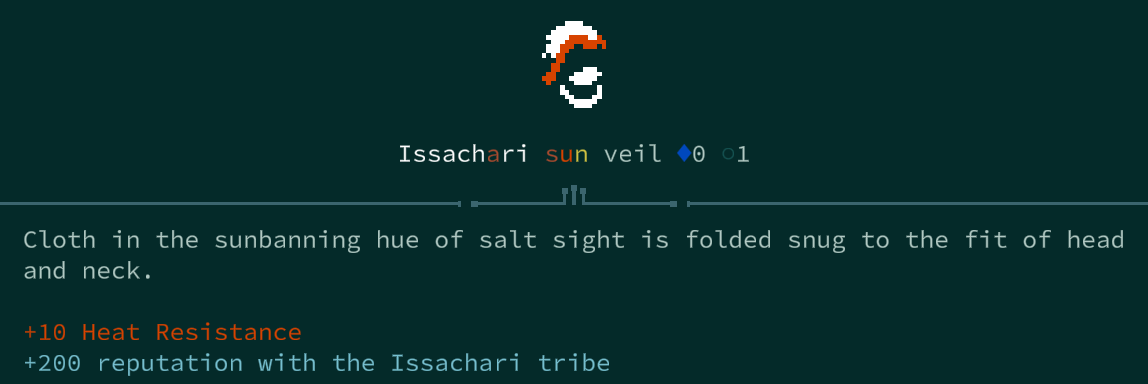
If, like me, you’re interested in faction-based play, I think there’s something to take away from that for our TTRPG games, so sit back and take a minute to endure (or enjoy?) my ramblings.
Establish Faction Web
Most of our games already have a variety of factions in use, even if they’re not explicitly labeled as such: the queen, the mayor, the lone witch in the woods, the goblin tribe hiding in the old dwarves’ mine.
Decide which ones are relevant to your current game. These can change by area or as the game goes on, but for now let’s say we’re building our starting area for a new campaign.
Use a piece of paper, post-its, a conspiracy board, a google sheet. Apps like Freeform on your mobile work as well.
I’d recommend using a minimum of four factions for this. A trio is possible as well, but much more rigid in use. Four gives each faction 3 possible relationship strands to use: friendly, hostile and neutral.
In its simplest form, it might look something like this:
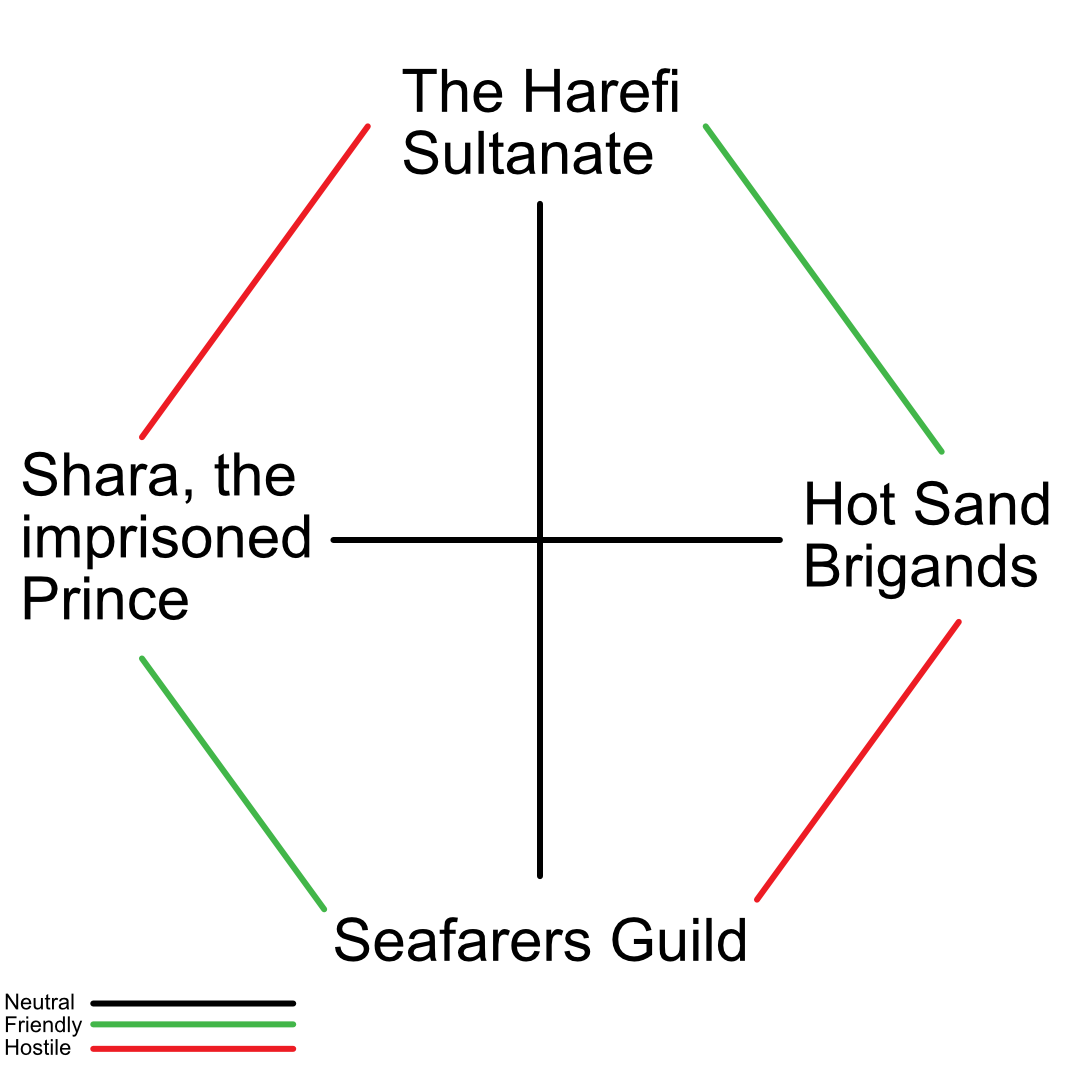
Using four factions also give you some flexibility to play around with setups, like this: 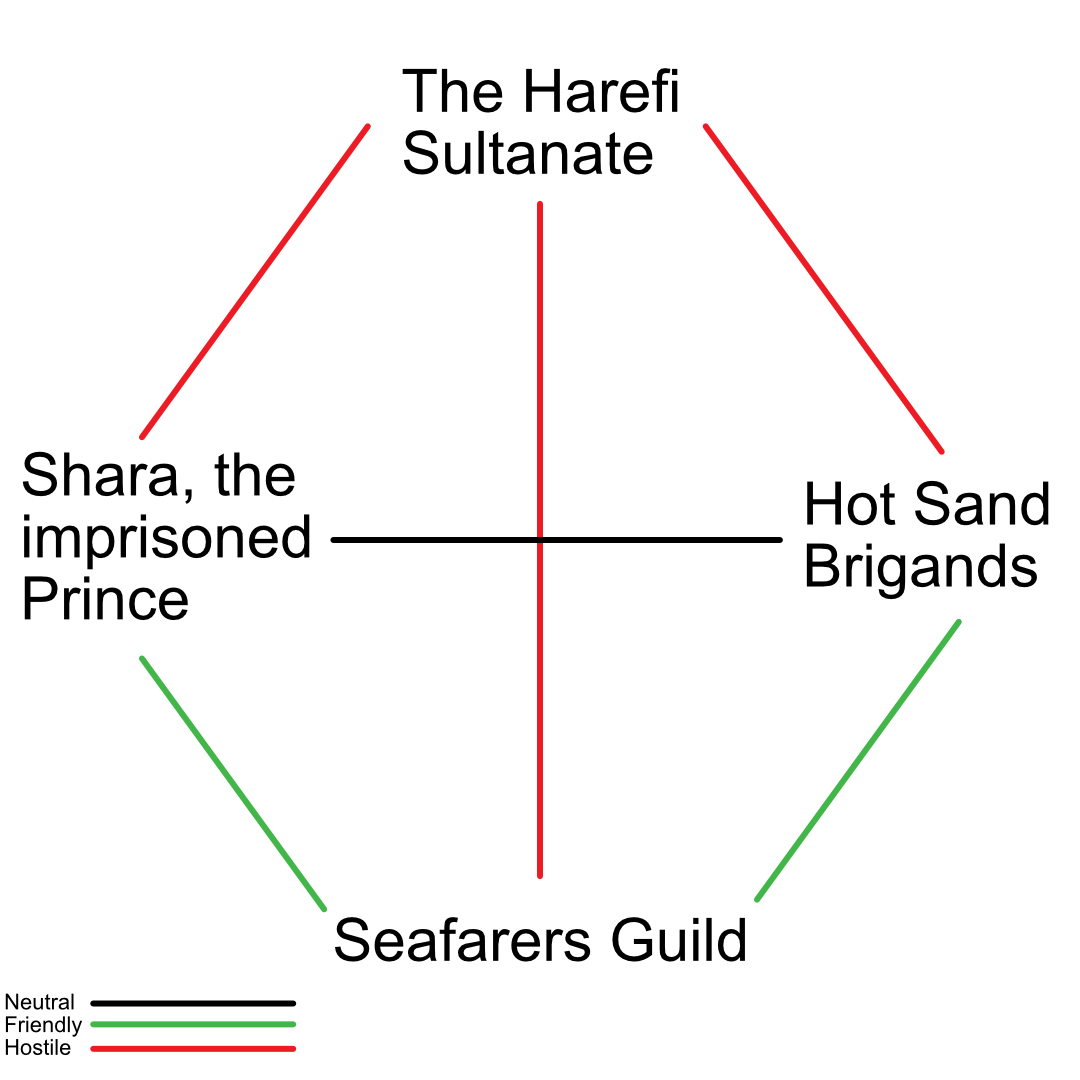
While four factions are enough for engaging play, I personally would use five, because that one additional faction can be used as a wildcard to come into play later, or to create more interesting situations:
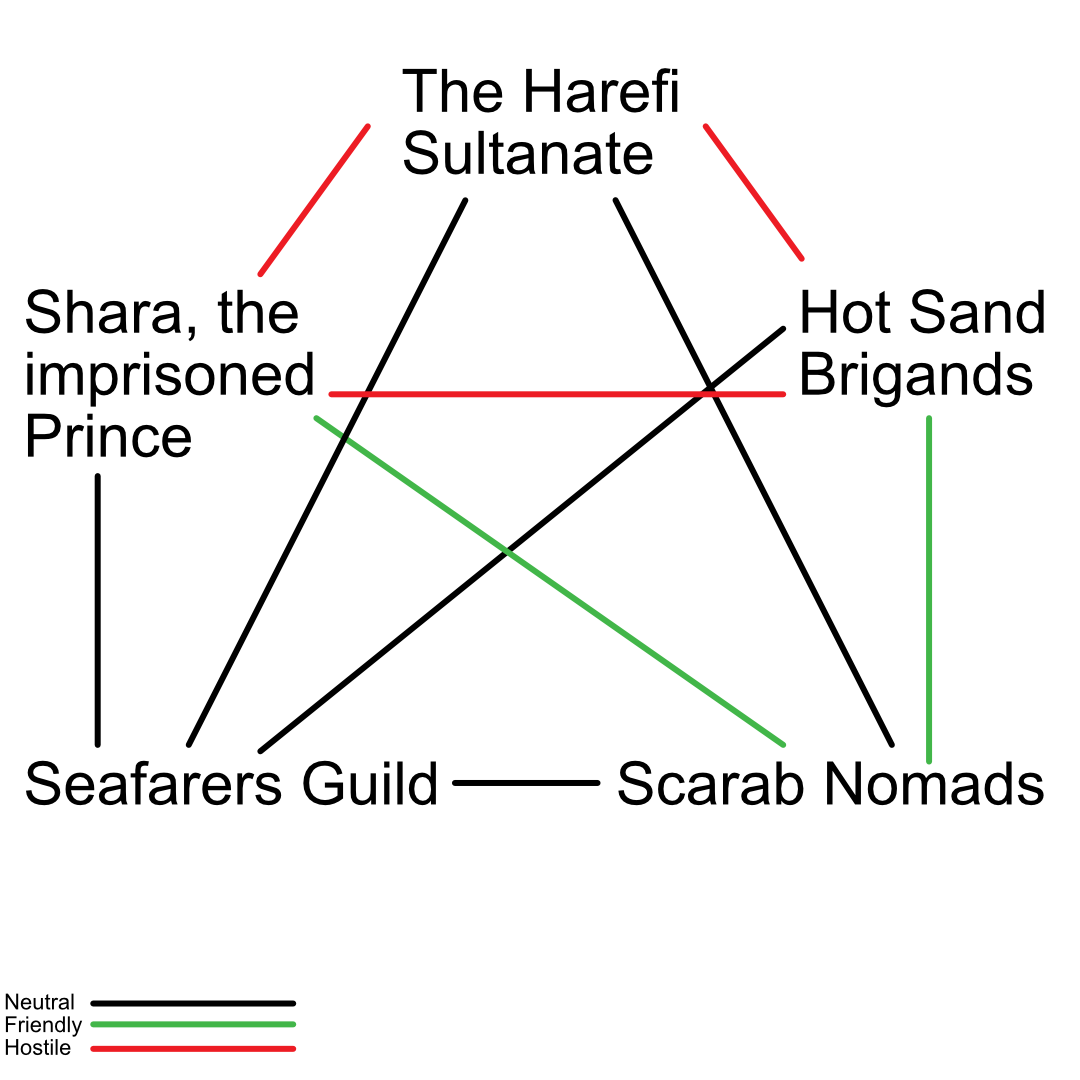
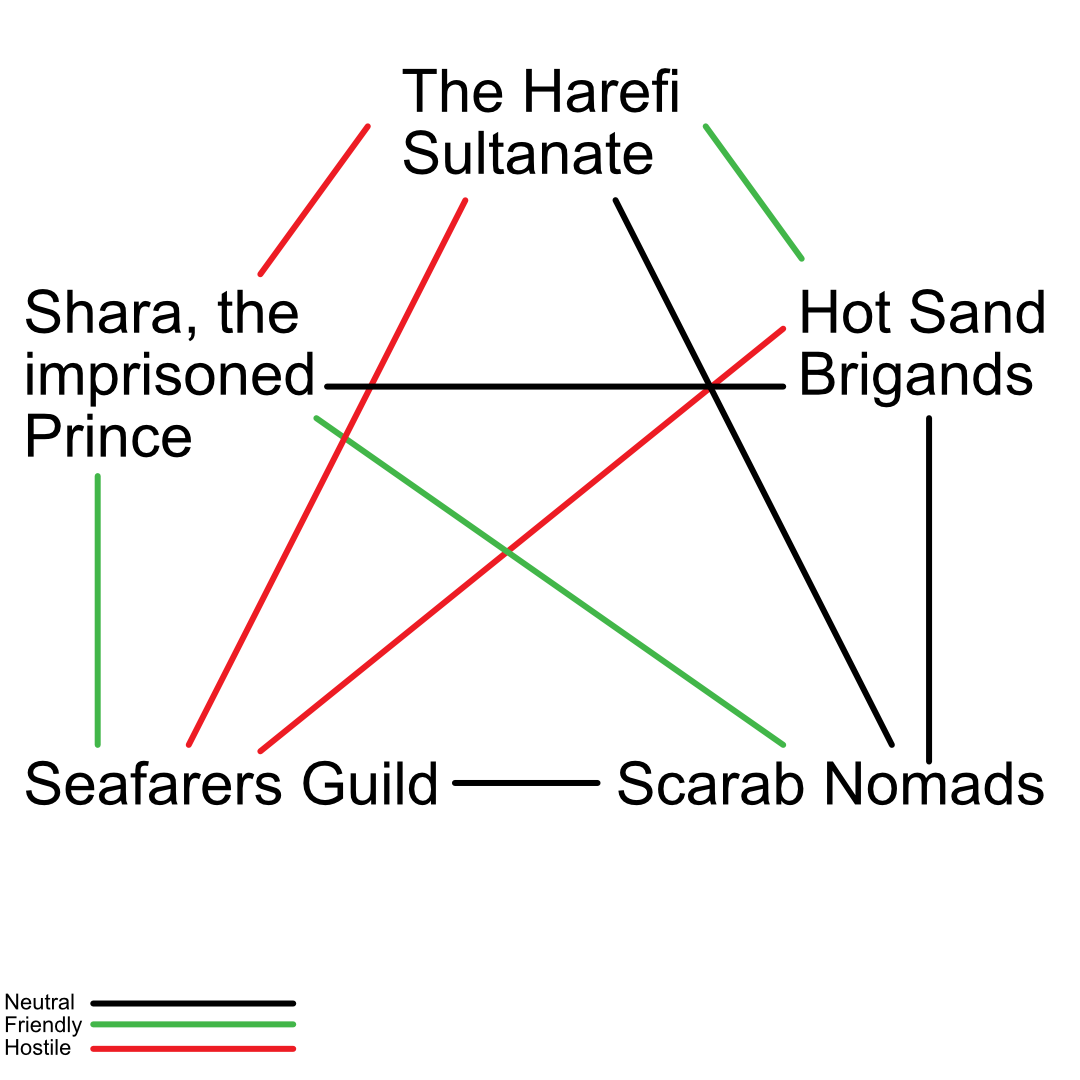
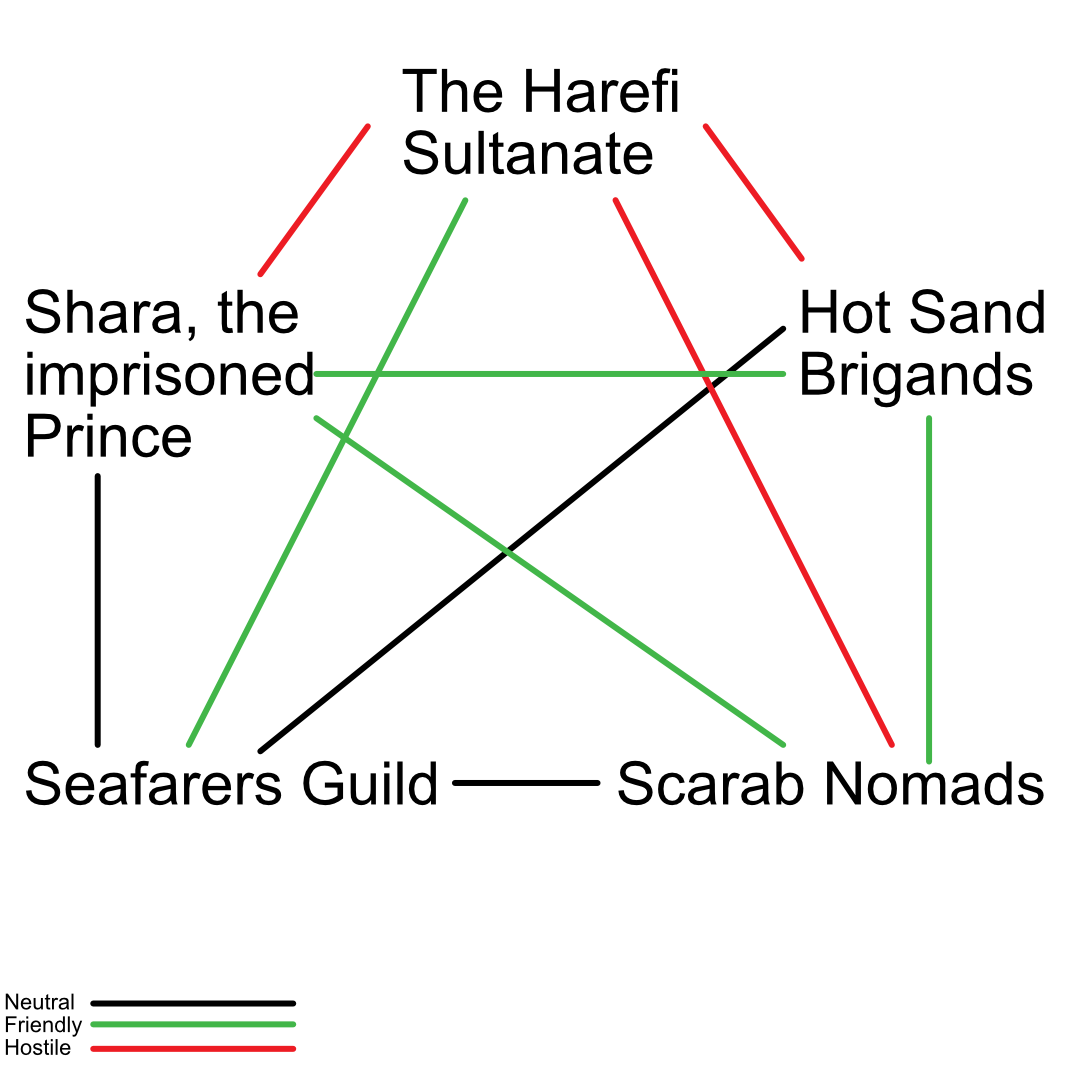
Each one of these picture vastly different situations and possibilities for the player characters to get involved.
Anything above five factions increases the complexity of the web, but might be used for very specific setups, such as these:
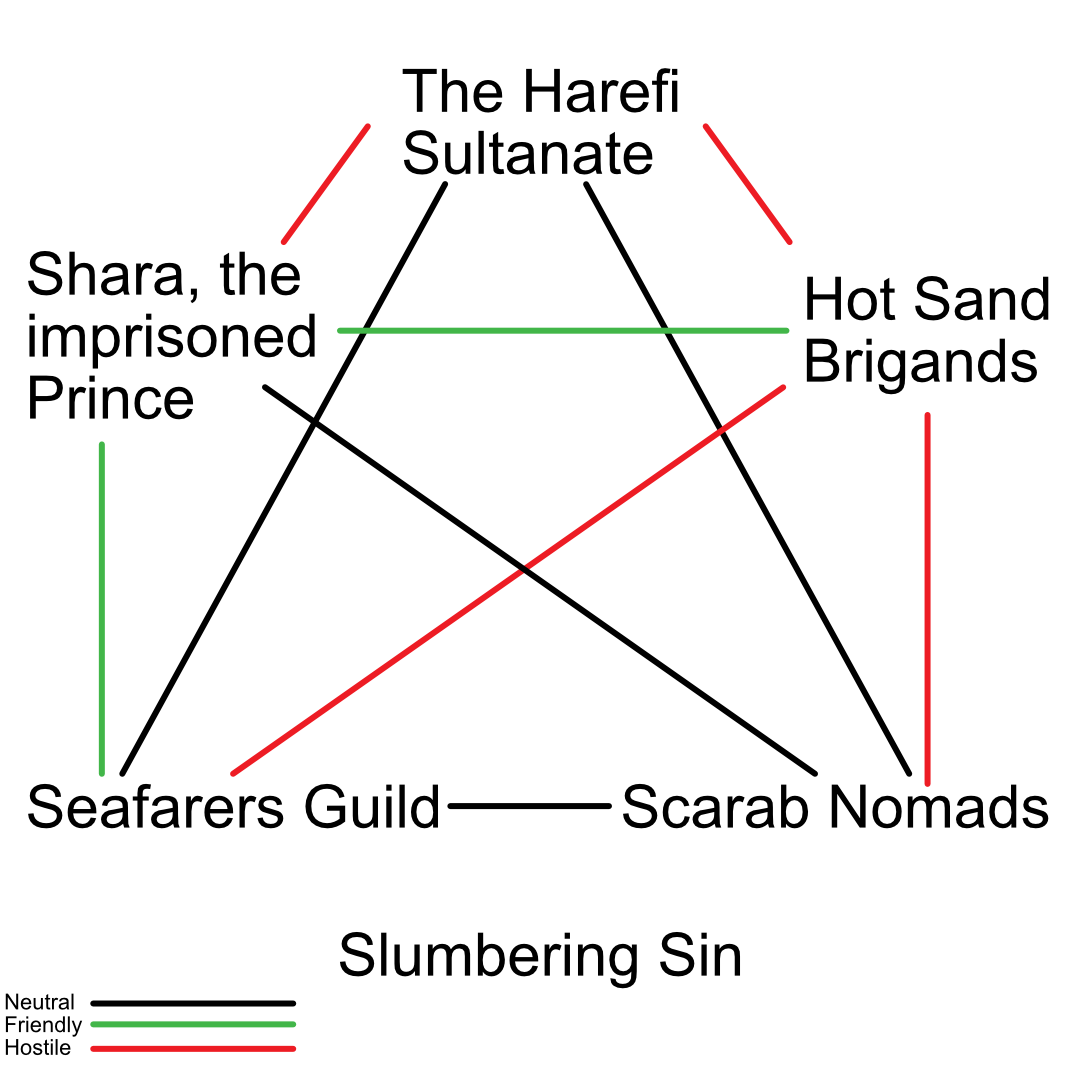
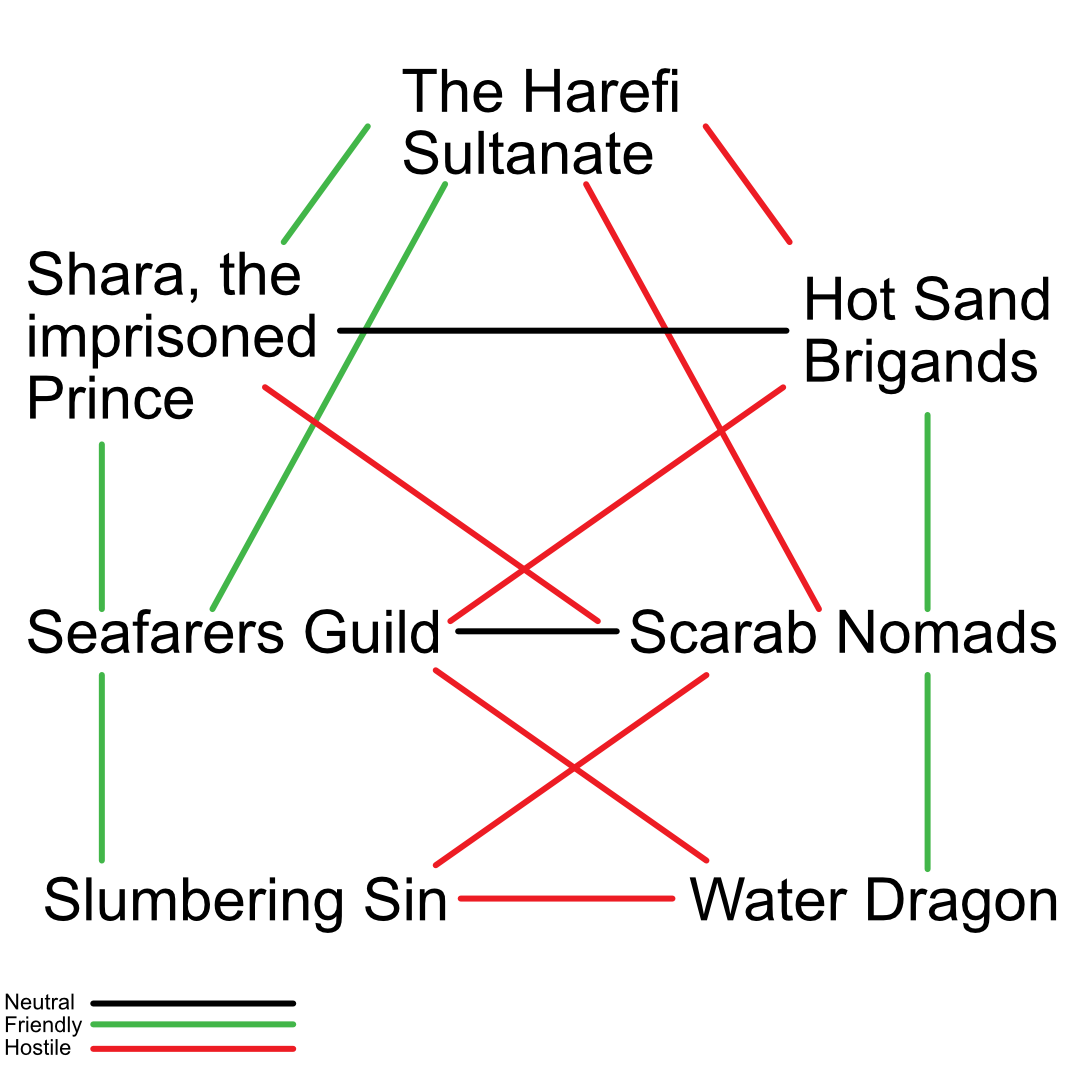
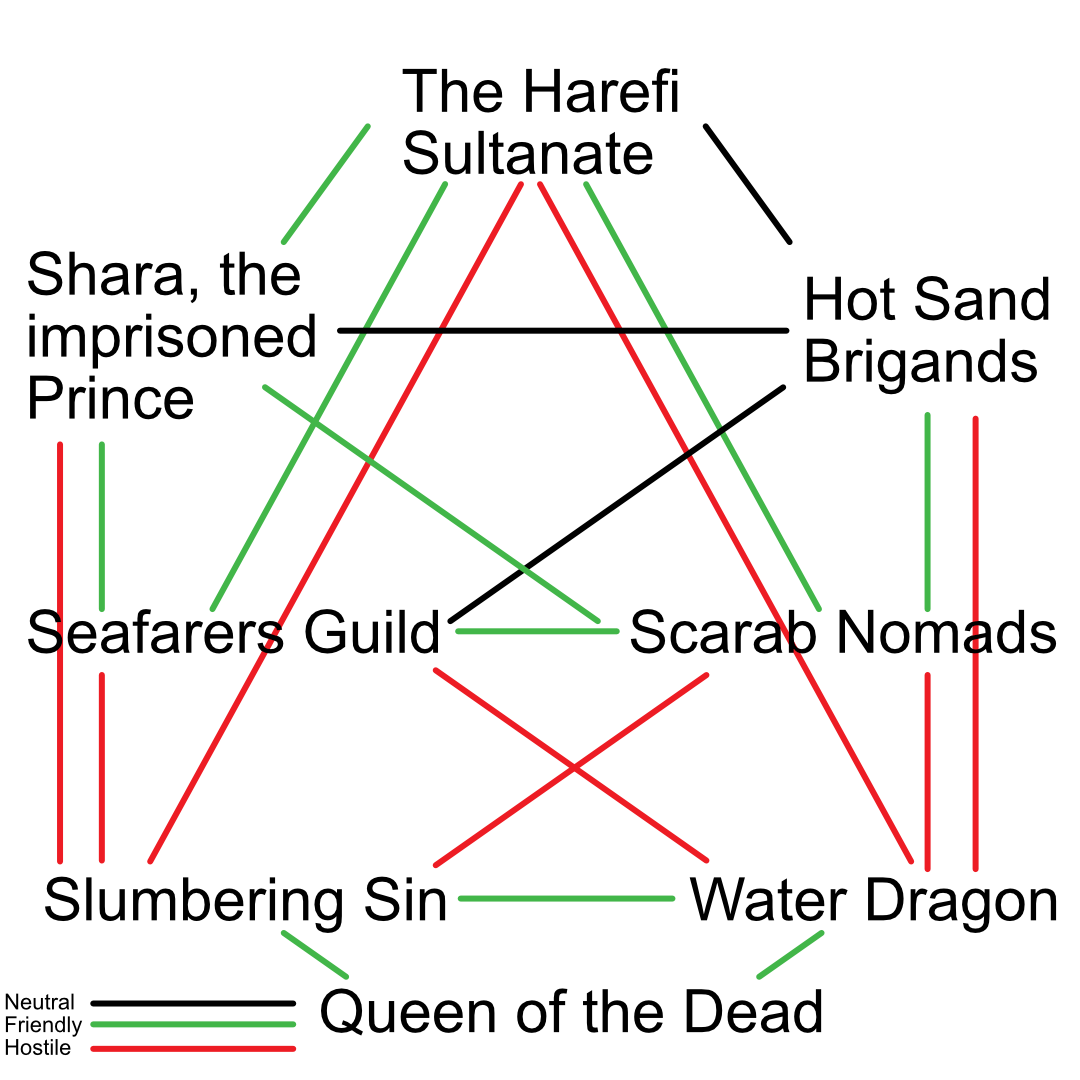
If that many or more factions are in play, a different kind of graphical representation should be used, as it can get confusing quite fast.
This is your baseline as the GM, but it’s not set in stone. More on that later (see ‘Shaping Relations’).
Enter the Player Characters
How does that relate to the individual player character, though? Let’s see:
For starters, the players might get a blank version of the web. You could also let them add them as they are discovered through play.
The back of the character sheet is a good place to write it down, mirroring their individual relations with the factions in play.
On the PC sheet, each faction has a reputation bar, ranging from hostile to allied. I’d probably use something like this, with 10s or 100s as increments:
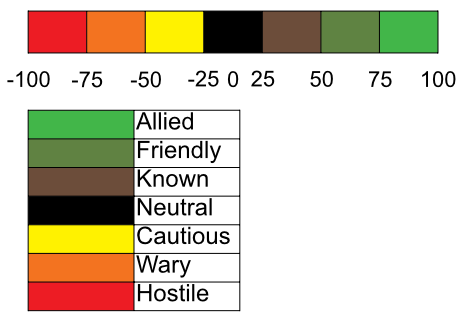
Or a more minimalist version using only raw numbers:
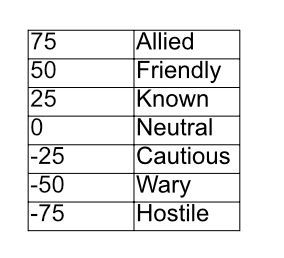
On the character sheet, it would look like this (I’m sticking with the minimalist variant here):
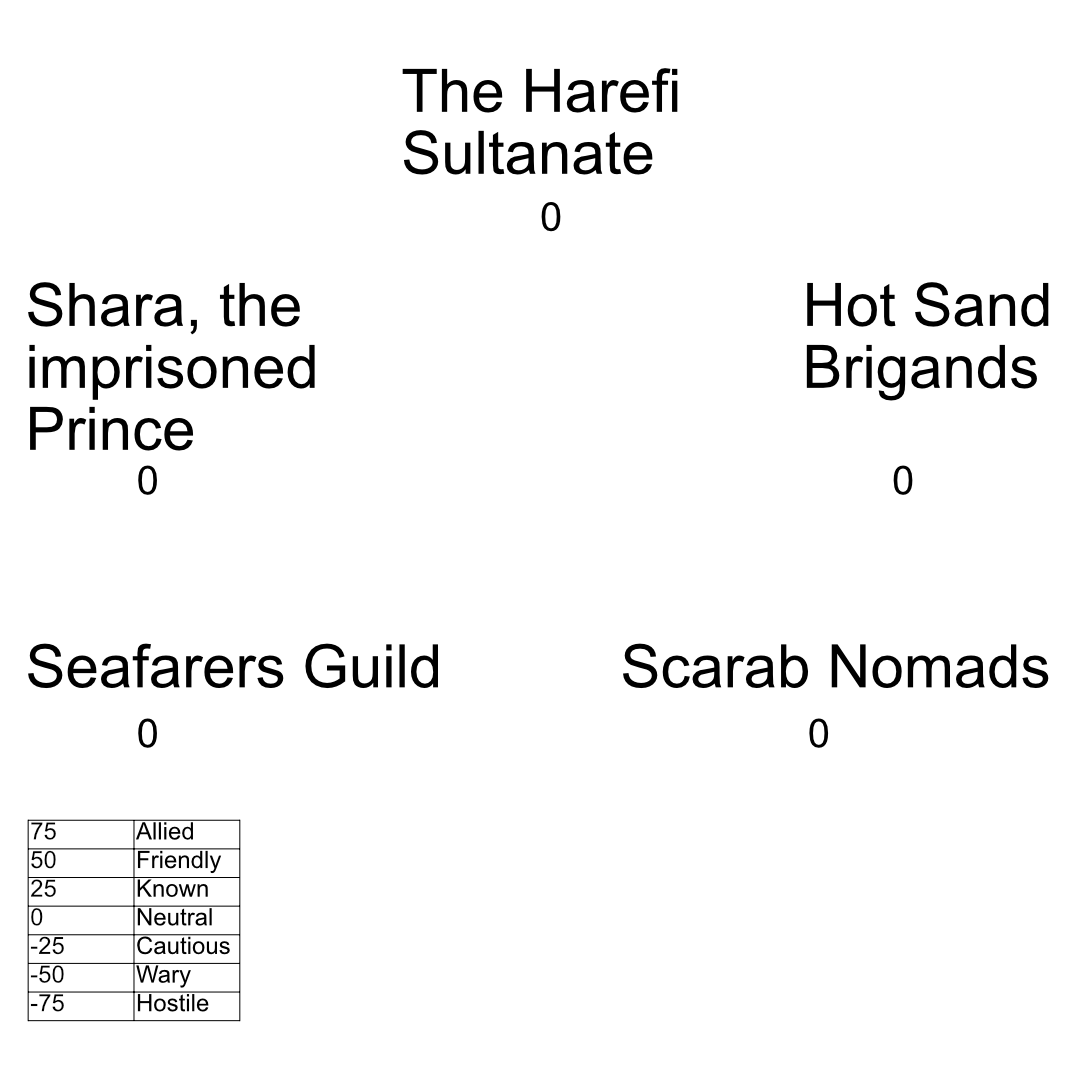
As the game goes on and players start to interact with the world, they gain and lose reputation with the factions, depending on their interactions. If using an XP-based system, completing a task might give 1/10th of the XP as reputation points. The players keep track of this using the reputation bars on their character sheets.
Here’s the thing though: gaining reputation with one faction causes a loss of the same amount with this factions’ rivals.
In our first example with five factions above, gaining 30 points of reputation with the Harefi Sultanate would put a PC to “Known”, while simultaneously to “Cautious” with Shara, the imprisoned Prince; because these factions are hostile to one another.
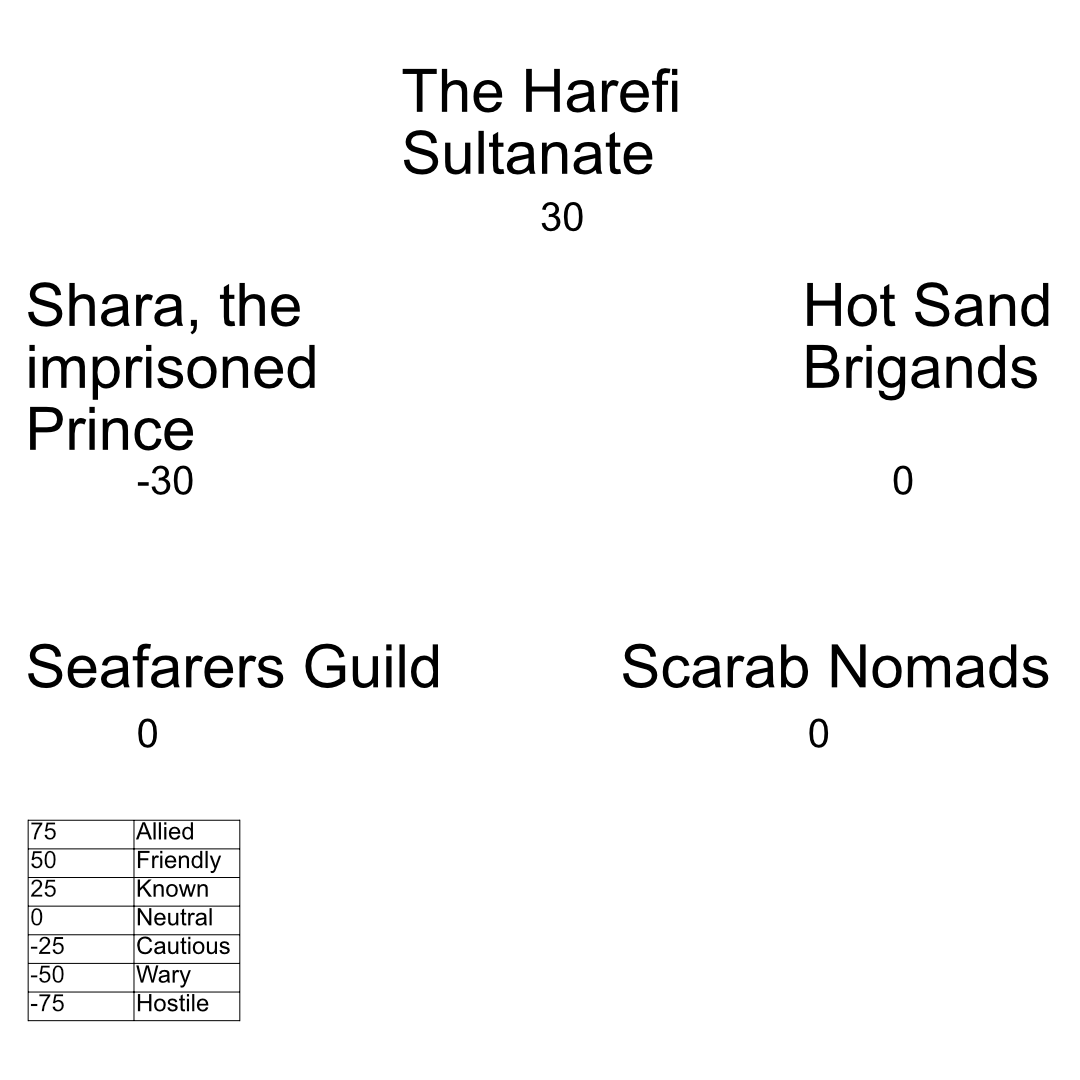
If the 30 points of reputation were earned with the Seafarers Guild instead, no negative reputation would have been earned, because in the example, that faction is a neutral party to all others.
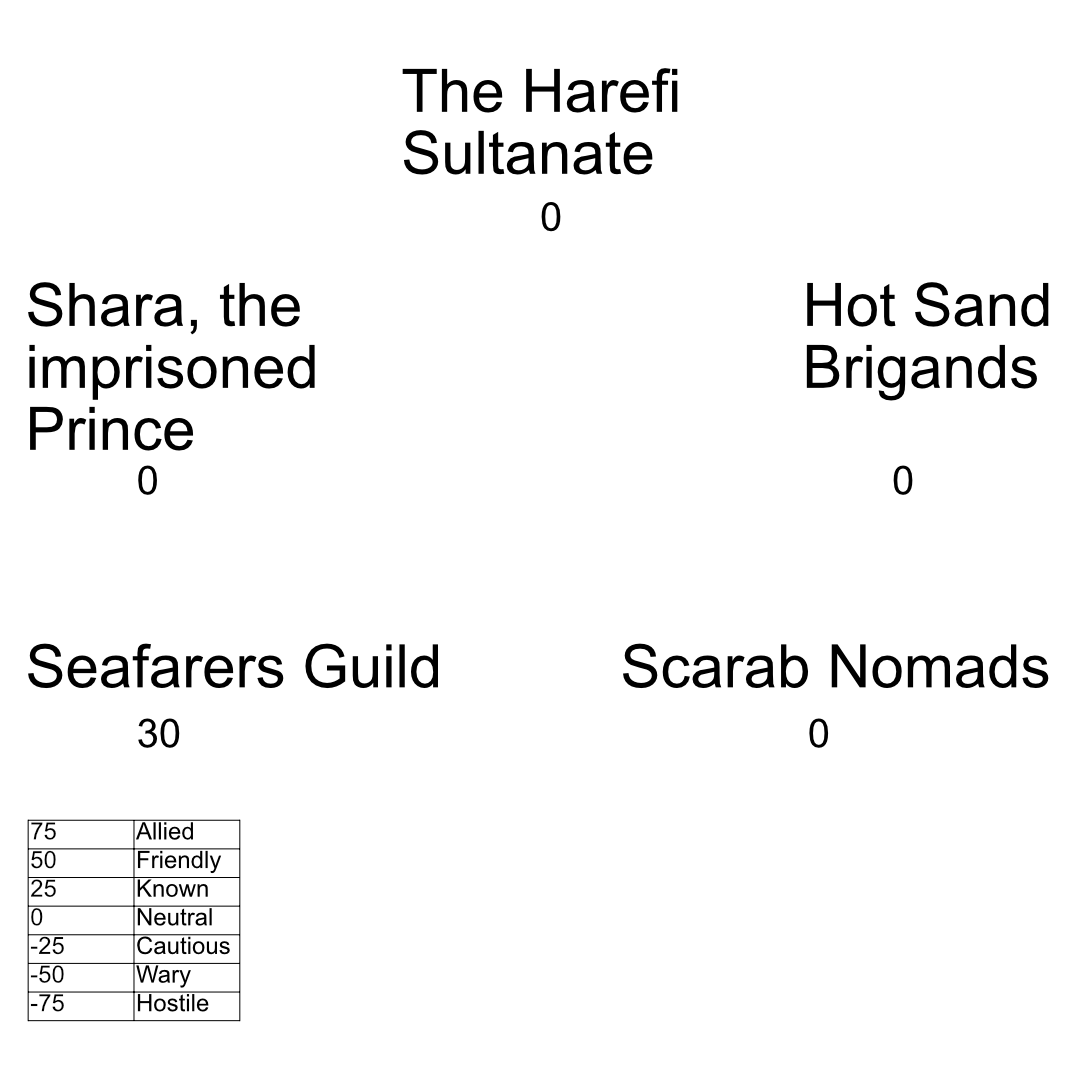
This way, the use of a reaction roll when interacting with certain factions becomes more and more obsolete, as the PCs gain more renown or notoriety within the world.
It might even lead to unforseen, but campaign-defining situations in play: The viziers’ secret service might seek a PC out for a delicate job for the Harefi Sultanate, because they’ve come to be trusted. A pariah of the Scarab Nomads might see a possible ally in a PC in conflict with them.
The reputation thresholds can also be used to gate access within the faction. A standing of Known enables you to hire faction henchmen, who are more experienced that the ones met in the pub. A minimum standing of Friendly might be needed to enter faction-specific places (such as holy sites or hideouts), while being Allied offers new or secret information, or opens up more trading opportunities.
The same is true for negative reputation. While only a Standing of Hostile leads to be attacked on sight, each step before that increasingly hinders access to that factions members, territory or resources.
To avoid murder hoboing and “reputation grinding”, killing members of a faction only leads to reputation loss with it, but never to reputation gain with another (even opposed) faction. Important personae within a faction might pose an exception, but only when killed as part of a task or mission. You don’t go around kingslaying without your allies critically eyeing your behaviour. After all, who’s to say they won’t be on the receiving end of that blade in the future?
Starting Relations
You might want to start with a neutral situation, the classic “party full of strangers in these lands”. Every faction starts at 0 and they slowly leave their mark on the world.
This a approach might work best in open table games, where the playing party changes from one session to the next - leading to varying PC reputations among the factions.
But your regular friday night or even solo game can also benefit of keeping track of the PCs standing, incentivising emergent play.
In a mixed party, this can lead to interesting roleplay opportunities:
Why are members of warring factions travelling together? Might their shared experiences bring more commonalities than differences to light, so they decide to act as envoys and try to find a diplomatic way to end their factions’ conflict? Or will they part ways as enemies after the job is done and meet again on the battlefield one day?
How do they smuggle that one notorious PC through the capital?
Or maybe you want to play a themed campaign with the PCs belonging to a faction already, thereby predetermining their relations with others. Do they stay that way or change as the campaign goes on?
Shaping Relations
For a more complex and diplomatic game, you could also offer the opportunity to forgo personal reputation gain to affect inter-faction relations:
A PC could use that newly gained 20 reputation reward not for themselves, but to change this factions relationship with another from hostile to cautious. Work their asses off to help bury the hatchet between the Capulets and Montagues.
You might want to use a reputation requirement before this kind of influence can be exterted, though.
Also, by using reputation-bonuses on specific equipment, you can open up a whole new level of player-world interaction:
Enemy uniforms can be used to move in their territory for covert missions, provided you keep a helmet on.
The merchant prince could be fooled by dressing up as one of their peers.
One of the PCs becomes a walking legend in their motherland because they found the sword of the conqueror and dare to wear it openly (possibly estranging the current ruler).
Reputation Item Generator
If you want to make use of faction-related equipment, a random table does the trick. This d100 example uses very flat numbers while leaving a 40% chance of non-faction related equipment. You get the idea, adjust at your leisure:
1-20 ordinary
21-25 +10 bonus reputation with faction 1
26-28 +20 bonus reputation with faction 1
29-30 +50 bonus reputation with faction 1
31-35 +10 bonus reputation with faction 2
36-48 +20 bonus reputation with faction 2
39-40 +50 bonus reputation with faction 2
41-45 +10 bonus reputation with faction 3
46-48 +20 bonus reputation with faction 3
49-50 +50 bonus reputation with faction 3
61-65 +10 bonus reputation with faction 4
66-68 +20 bonus reputation with faction 4
69-70 +50 bonus reputation with faction 4
71-75 +10 bonus reputation with faction 5
76-78 +20 bonus reputation with faction 5
79-80 +50 bonus reputation with faction 5
81-100 ordinary
Mothership - d10 Blue Collar Mission Generator
Update: a slightly revised version of this generator is now available on my itch.io page! Check it out!
A recent bluesky exchange I had was about the lack of ‘mundane’ modules for Mothership. Especially in longterm play, alien horror after alien horror diminishes the survival chances of individual player characters.
Sure, the modules can be months or years apart and there’s rules for downtime activities in the meantime - learning new skills takes years, after all.
But I think a Space Trucker themed campaign can only take so much alien confrontations before the tone of the campaign shifts.
And what if you wanted to run a game where the horrors were only a selective occurrence?
If you don’t need every game session to be the worst day in the PC’s lives, here’s a bunch of d10 tables to generate some - not necessary harmless - blue collar missions in space:
Client
- Ye olde Mom&Pop Shop
- Corpo Gal
- Bartender
- Retired Space Trucker
- Talking Cat
- Fixer
- Drinking Buddy
- Relative
- Union Contact
- Religious Group Member
Task
- Exterminate infestation (roll on Infestation table)
- Android maintenance
- Clean that thing (roll on Stationary Things table)
- Repair that thing (roll on Stationary Things table)
- Scrap that thing (roll on Stationary Things table)
- Recover that thing (roll on Movable Things table)
- Deliver that thing (roll on Movable Things table; roll twice on Target Location table to determine start and destination locations)
- Smuggle that thing (roll on Movable Things table; roll twice on Target Location table to determine start and destination locations)
- Organize a Strike
- Doggy Daycare
Infestation
- Evolved Food Leftovers
- Mold
- Blue Algae
- Grasshoppers
- Rats
- Cockroaches
- Spiders
- Common Flies
- Rogue AI subroutines
- Nanomachines
Stationary Things
- Station Reactor
- Space Lift
- Life Support System
- Heavy Machinery
- Volatile Gas Container
- Plumbing System
- Orbital Space Debris
- Radioactive Waste Facility
- Ship Engine
- Terraforming Machinery
Movable Things
- Contraband
- 1d100 Cat(s) - good luck!
- Offspring (50% unwilling)
- Family Heirloom
- Fuel
- Regular Supplies
- Religious Artifact
- Intel
- Emergency Supplies
- Lost Ship
Target Location
- Space Station
- Moon Colony
- Gas Giant Refinery
- Derelict Gas Freighter
- Asteroid Mine
- Corpo Headquarters
- Research Facility
- Military Outpost
- Orbital Wharf
- Waste Removal Facility
Complications during work
- Hull breach
- Union Riot
- Security Lockdown
- EMP from a nearby Pulsar
- Space Pirate Attack
- Fire Outbreak
- Incoming Asteroid (d10 hours until impact)
- Life Support System Malfunction
- Water leak
- Sudden Solar Flare (Level 3 radiation)
Mission Twist
- Roll twice for Complications
- Client can’t deliver on reward (50% chance of upfront honesty)
- Client secretly is an AI (50% has benevolent intent)
- Task is a test for further work
- Task is illegal here (50% client knows)
- Task is also pursued by rival party (roll on Rival Party table)
- Task will need to be done in Zero-G Environment
- Find an old holodisk with a treasure map on location
- Location will cross the event horizon of a black hole in 1d10 hours
- Complication is known upfront
Rival Party
- Ultra-efficient Android Taskforce
- Out-of-luck Bounty Hunters
- Space Truckers (50% chance of being drunk)
- Former Associates (50% chance of being on good terms)
- Union Members (50% chance of being from a rival union)
- Bunch of Nerds
- Xenophobic Assholes
- Corporate Mercenaries
- Self-Aware Androids
- Veteran Ex-Marines
Reward
- Gratitude
- Favor
- Reputation
- Weekload of Supplies
- Monthload of Fuel
- Follow-up Task (double reward next time)
- Stash of vintage Heavy Metal Music CDs
- Intel
- Contact arrangement
- Ship Repair Parts
The Warden will oviously need to flesh out the details, but these can provide a fun framework to work with. If you can’t or don’t want to roll all these d10s yourself, here’s the whole thing in a neat perchance generator.
Let me know what you think!
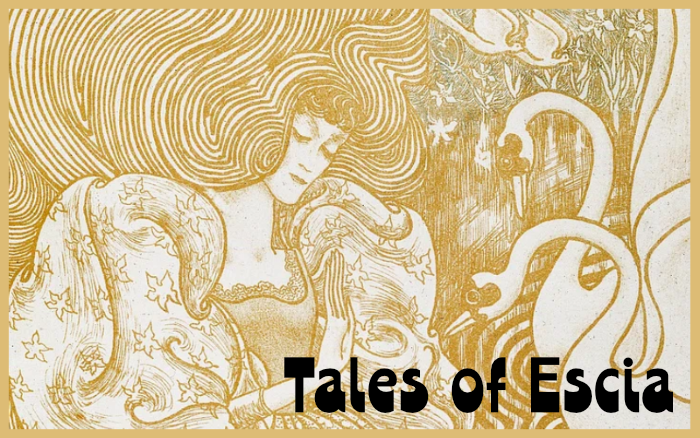 Tales of Escia
Tales of Escia
TALES OF ESCIA: Running an OSE Hexcrawl 09
Player Characters
Melora Kriss - Human Druid
Myr’tacae Malenia - Elf Fighter
The Premise
As explained in my previous article, we’re running a modified version of Old-School Essentials in a minimalist romantic fantasy setting, which will be fleshed out as we play.
We began with our first session of B2 - Keep on the Borderlands and decided on a bi-weekly rhythm every second wednesday evening, playing for 2 hours.
For the play report of the previous session, click here.
Session 09 - Stupid sexy demigod!
TL’DR: The party spends an evening partying like ancient greeks and returned to Margrave Keep to find an unpleasant surprise.
Everyones invited!
The group of fauns invited Myr’tacae t join their merry evening and escorted her to the human figure, who turned out to be Dionysos, demigod of wine and revelry (yes, the himbo demigod as depicted in the video game Hades).
She was offered to stay for the party, and, talking about the people she left behind, free to bring them over also.
Myr’tacae went back and got everyone, except for Sandy Honeyman (already asleep) and the breggles who stayed to watch him.
Don’t blink
As the evening went on, the fauns seemingly increased in numbers everytime one blinked.
In a private conversation with Melora and Myr, Dionysos offered to help with the goings-on in Margrave Keep and the Caves of Chaos, in exchange for them checking out a place called Sunbelow Abbey. A monastery to the southwest and source of the best wine in this region, the flow of wine stopped recently for unknown reasons. As a show of goodwill, Dionysos provided the party with a possible location for Stepladder Burke, the missing mage from Margrave Keep.
Return to the Keep
The next morning, the party and their entourage continued their trip to Margrave Keep.
On their arrival, they were confrontd with captives of the Addercapper brigands on pillories, held for possible execution.
Pearl went home to her husband immediately. The party went and informed Woken-Too-Early about the dealings with the hobgoblins and asked him, if some of the Addercapper captives could be deputized to help the group, if not outright pardoned.
Woken-Too-Early went on to explain the martial hierarchy and informed them of persons of higher station than Commander Margrave in the city of Specularum to the south, to possibly overrule Addercapper executions.
Closing thoughts
Faction action! Ever since the unintended mention of the Addercapper brigands to Commander Margrave in session 6, I’ve been tracking their knights’ efforts in tracking down the fugitives. By the end of session 9, they have been searching for ten ingame days.
I made two contesting four-part clocks for each faction and, using the Mothership systems’ downtime rules, rolled 1d100 every two days for the knights. A success on even numbers for one faction meant a failure for the other.
After four rolls I had 3 successes for the knights and 1 success for the brigands, which meant the knights rounded up most members of the small group, but not all of them.
See you next time. =)
 Tales of Escia
Tales of Escia
TALES OF ESCIA: Running an OSE Hexcrawl 08
Player Characters
Melora Kriss - Human Druid
Myr’tacae Malenia - Elf Fighter
The Premise
As explained in my previous article, we’re running a modified version of Old-School Essentials in a minimalist romantic fantasy setting, which will be fleshed out as we play.
We began with our first session of B2 - Keep on the Borderlands and decided on a bi-weekly rhythm every second wednesday evening, playing for 2 hours.
For the play report of the previous session, click here.
Session 08 - Of hostages and demigods
TL’DR: The party bought the hostages’ freedom and were in for a divine surprise on the way back to Margrave Keep.
Negotiations
After a few hours of waiting, the party was picked up by the guard they met the day before and brought to the meeting with the hobgoblin chieftain.
The meeting was held in the common room after dinner, and after the tables were emptied, Melora and Myr’tacae found themselves alone with five hobgoblins: the chieftain and his four wives - one of which was lying head down on the table, snoring rather loudly.
The chieftain himself was rather open-minded about reestablishing positive relations with Margrave Keep, although he insisted ransoming back the hostages.
The wife nearest to him, and next to the sleeping one, was not so agreeable; trying to convince him of their current course. But, being outargumented four-to-one, her defense of concerns and fear mongering quickly crumbled, and she admitted defeat.
When being confronted with her overtly agressiveness, she admitted semi-regular contact to a man dressed in black robes - someone who tried to contact the chieftain, but
was turned down because he found them too suspicious.
The chieftain confirmed the beginning of the discourse in the demihuman camp as corresponding with the time the man in black started visiting the different folks living there, while his wife described him as being overly nice and giving out presents, showing a silver bracelet to the group.
After agreeing about the ransom, Makkad brought the party to the room where the hostages were held, as the chieftain needed to adress another emerging problem: A scout matching the description of the dead hobgoblin in the goblin storage was reported missing and the camps guards suspect the neighboring orcs as the culprits. Makkad and the party exchanged glances, but otherwise kept their silence.
Freeing the hostages
At the prison, they found the halfling merchants wife, Pearl, as well as another halfling introducing himself as Sandy Honeyman, an obnoxiously positive jam vendor, a human called Loren Ipson who speaks only gibberish, as well as three religious breggles who went on to praise St. Marcia for their timely rescue.
The party agreed to escorting the six ex-hostages back to the keep, agreeing to depart as soon as possible.
Makkad gifted them a small chest containing some coins and a small wooden wand for their help, as well as the leftovers of the sleeping herbs, before they left.
Late night festivities
On the way back to Margrave Keep, the dice indicated another random encounter for the night - “a demigod or his avatar”.
After turning in for the night, the travelling group noticed rythmic music and chanting slowly growing louder from all around them and when Myr’tacae went to investigate, she discovered a human-looking man and an entourage of fauns surrounding a campfire in jolly celebration.
When she tried to back away and return to the camp, the fauns noticed her and gaily approached her.
Closing thoughts
Melora and Myr’tacae are on the way to complete their first major quest - Pearl walks free once again!.
The talks with the hobgoblin chieftain were largely in their favor, as the remaining traditionalist wife had little to pressure him with when she found herself cornered by her opposition. Nevertheless, she gave some more insight in what is going on in the recent past events.
Most of the hostage NPCs were taken from Gig Economy, a neat little supplement containing 200 retainers, hirelings and henchmen. I’m having a lot of fun with them, especially Loren Ipson, who just recites the Lorem Ipsum text but otherwise seems to be a decent fellow.
We also had a lot of fun with Melora trying to bond with Sandy Honeyman over her love for apiculture and him dead-pan not being into it, despite his name.
The divine random encounter ended the session on an unexpected note and I’m excited to see how Myr’tacae reacts to the requests
and whims of what is basically a being possessing awesome power, but the temper of a five-year-old.
See you next time. =)
 Tales of Escia
Tales of Escia
TALES OF ESCIA: Running an OSE Hexcrawl 07
Player Characters
Melora Kriss - Human Druid
Myr’tacae Malenia - Elf Fighter
The Premise
As explained in my previous article, we’re running a modified version of Old-School Essentials in a minimalist romantic fantasy setting, which will be fleshed out as we play.
We began with our first session of B2 - Keep on the Borderlands and decided on a bi-weekly rhythm every second wednesday evening, playing for 2 hours.
For the play report of the previous session, click here.
Session 07 - Bee my honey bee
TL’DR: Bee-autiful creatures and dead hobgoblins, oh my! The party gathers narcotic ingredients and discovers a corpse that could spell trouble in the future.
A detour
The party left Margrave Keep on the next morning to head back to the demihuman camp and arrived there without issue. Before heading back to the hobgoblin camp, they remembered their talk with Makkad and decided to head further south first to search for a plant that could be used as a narcotic.
Being a beekeeper/gardener and local from Saltmarsh, we established that Melora would know the local flora and which herbs and plants were used in the making of sleeping potions.
Their search led further south, to the edge of the Maned Serpent Glades.
Bee-autiful creatures
Entering Hex 0702, the dice indicated a random encounter for this day, namely “2d6 Thriae in conference. Critical of visitors.” They are a kind of nymph, with women’s head and torso and lower body and wings of a bee. Local legends say they possess the power of divination.
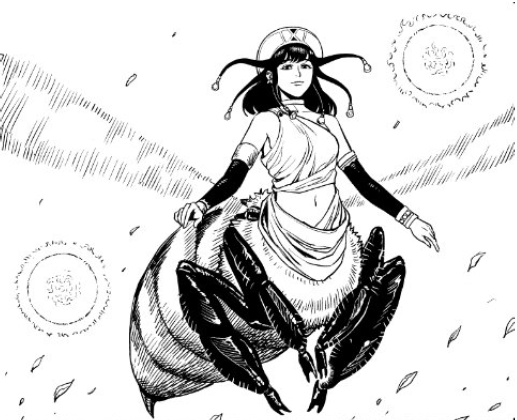
Skittish and wistful creatures, Thirae can sense the shape of the future and are generally disappointed. - Picture and description from The Monster Overhaul
I rolled up 4 of them on a meadow filled with wildflowers, not far off the main road. Players being players, they couldn’t just ignore them and decided to approach.
The creatures being half woman, half bee and all of us being Final Fantasy XIV players, the games’ current bee-hype certainly influenced the decision.
Swarmaline, queen bee to be
Becoming aware of Melora and Myr, three of the Thriae began circling them cautiously. The fourth and biggest of them introduced herself as Swarmaline, the swarm leader.
Thanks to Meloras beekeeper experience, the conversation quickly shifted from “critical of visitors” to a more mellow mood. Swarmaline knew where the plants they looked could be found, but wary of people taking more than they needed. Melora convinced her that they would only harvest a few and was given directions.
Curious of how much truth the legends hold, Melora asked about the Thriaes’ power of divination and Swarmaline offered to give her a prophecy in exchange for something of worth. Melora offered a bundle of lavender from her starting equipment, which the swarm happily accepted, as it helped in building their new hive.
Swarmalines prophecy was cryptic as could be: A great battle will be fought in the sky.
Return to the Caves of Chaos
Parting ways with the Thriae, the party gathered their herbs and headed back to the demihuman camp and decided to pay a visit to the goblins first. They were greeted by Dandelion, who was a) sad he was left behind and b) in distress, because the storage held an ugly surprise.
The party learned that two days before their arrival, a hobgoblin had sneaked into the storage chamber and was surprised and subsequently killed by one of the guards. The guard in question, Pinecone, seemed very inspired by Dandelions latest exploits and apparently took much pride in his job and his kill.
Since no one came looking for the hobgoblin in the meantime, the party decided it might be better to not further complicate their coming talks with their chieftain with news of his dead clan member. Luckily the storage chamber acts as a natural refrigerator and the goblins were willing to keep their secret a little longer.
Meeting again with Makkad, the party provided her with the herbs and they
went over the plan: Makad would mix the herbs into the food of one of the opposing wives and would then petition the chieftain for a meeting with Melora and Myr. They would go back to the goblins for now and wait there until being called on.
Closing thoughts
After almost two month of not playing because of life stuff, we finally got together again, albeit for a slightly shorter session than usual. This has become somewhat of my comfort campaign. There’s something very freeing about leaving most things up to random tables and dice rolls and the added free time because I don’t have to prepare very much between sessions.
And yet, the dice help tell a story and flesh out the characters as we play, as we’ve just seen here with Melora and the Thriae, deepening the theme of her being very invested in everything apiculture - a trait that started with the beekeper suit in her starting equipment.
I think I said it somewhere before, but I love Skerples’ The Monster Overhaul. Most of the random encounters for this hexcrawl are based on this book, including the 30 baboon harem and now the Thriae and the obscure prophecy. It’s the most
imaginative monster book I’ve read until now. I’m excited to see they’re seemingly working on another thing, a treasure overhaul.
Swarmaline is now part of the Recurring NPCs table, so I’m sure we haven’t seen the last of her.
See you next time. =)